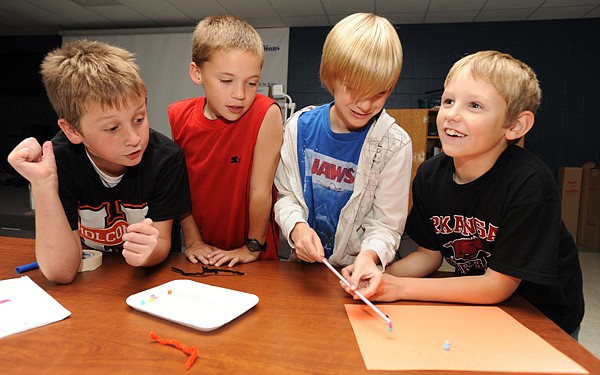FAYETTEVILLE — As an after school activity, a group of second-, third- and fourth-graders at Holcomb Elementary School are learning about trash — the kind of trash that has created an island of garbage in the North Pacific Ocean.
And, they are having fun.
Just don’t tell them they are also learning.
“This is fun because I get to experiment,” said 8-year-old Charlie Faught, a third-grader in Club Invention. The club is an after school program developed by a national organization, Invent Now, to foster interest in science among elementary age students.
The club meets at Holcomb for about 90 minutes Wednesday after school.
“The best subject is science,” Charlie said.
Fast Facts
Holcomb Elementary School
• Enrollment: 575 in kindergarten through fourth grade.
• Poverty rate: 41 percent of students qualify for free and reduced-price meals.
• Motto: Aim High
• Mascot: Hornets
• School Colors: Black and orange
Source: Staff Report
On a recent Wednesday, the students worked with a plastic egg to create an “eggmarine,” said Ashley Jones, one of the club’s sponsors. The concept the students were learning was buoyancy.
They used small magnets, plastic beads, bits of clay and even masking tape to create an “eggmarine” that floated in water for 10 seconds without sinking to the bottom or rising above the water line.
The students learn through the process how buoyancy plays a role in the build-up of trash in the ocean. Trash, mostly plastics, have accumulated from various sources in the oceans in part because of currents, according to the National Oceanic and Atmospheric Administration.
“They are playing with water and using their hands,” said Jenny Gammill, director of K-12 science and instructional technology for the Fayetteville School District. “That time will stick with them for a long time. That’s why hands-on learning is so powerful.”
Science study provides another outlet for students to excel, even those who might not shine on athletic fields or elsewhere in school activities, Gammill said.
At a table in a multipurpose room at the school, Charlie and his teammates continued to try to make their egg buoyant. “One, two, three,” they counted before plucking the egg floating above the water line out of the water for another modification.
Some 25 students, all members of Club Invention, worked in groups of four and five to make their eggs buoyant.
More Fayetteville schools probably will add Club Invention to their afterschool programs next semester, Gammill said. The club is a companion to Camp Invention, which the school district held at Root and Leverett elementary schools, as part of the school district’s goal to introduce more science in the elementary curriculum.
The camps and the club are part of a national network of science education programs offered through Invent Now to provide summer and after school education in science, technology, engineering and math, often referred to as STEM education.
“It’s to complement classroom learning, hands-on learning,” Gammill said.
Principal Tracy Mulvenon joined in the discussion, explaining buoyancy in terms of scuba diving and the need for buoyancy while diving. She said the approach to learning excites the students.
“The kids can’t wait to get here,” she said.

